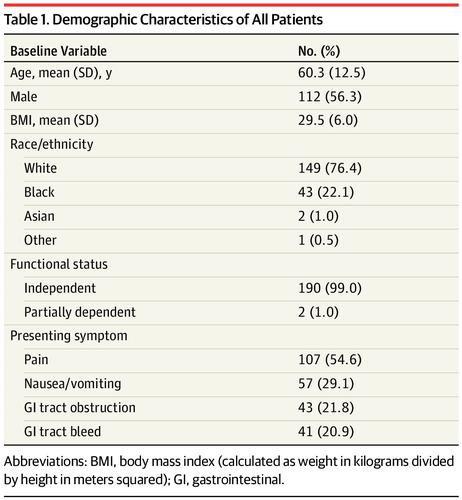当前位置:
X-MOL 学术
›
JAMA Surg.
›
论文详情
Our official English website, www.x-mol.net, welcomes your
feedback! (Note: you will need to create a separate account there.)
Prognostic Role of Lymph Node Positivity and Number of Lymph Nodes Needed for Accurately Staging Small-Bowel Neuroendocrine Tumors.
JAMA Surgery ( IF 15.7 ) Pub Date : 2019-02-01 , DOI: 10.1001/jamasurg.2018.3865 Mohammad Y Zaidi 1 , Alexandra G Lopez-Aguiar 1 , Mary Dillhoff 2 , Eliza Beal 2 , George Poultsides 3 , Eleftherios Makris 3 , Flavio Rocha 4 , Angelena Crown 4 , Kamran Idrees 5 , Paula Marincola Smith 5 , Hari Nathan 6 , Megan Beems 6 , Daniel Abbott 7 , James R Barrett 7 , Ryan C Fields 8 , Jesse Davidson 8 , Kenneth Cardona 1 , Shishir K Maithel 1
JAMA Surgery ( IF 15.7 ) Pub Date : 2019-02-01 , DOI: 10.1001/jamasurg.2018.3865 Mohammad Y Zaidi 1 , Alexandra G Lopez-Aguiar 1 , Mary Dillhoff 2 , Eliza Beal 2 , George Poultsides 3 , Eleftherios Makris 3 , Flavio Rocha 4 , Angelena Crown 4 , Kamran Idrees 5 , Paula Marincola Smith 5 , Hari Nathan 6 , Megan Beems 6 , Daniel Abbott 7 , James R Barrett 7 , Ryan C Fields 8 , Jesse Davidson 8 , Kenneth Cardona 1 , Shishir K Maithel 1
Affiliation

|
Importance
Little information is available regarding the minimum number of lymph nodes needed to accurately stage patients when performing a mesenteric lymphadenectomy for small-bowel neuroendocrine tumors.
Objectives
To determine the prognostic role of lymph node positivity and the ideal number of lymph nodes for accurately staging patients with small-bowel neuroendocrine tumors.
Design, Setting, and Participants
This case series from the US Neuroendocrine Tumor Study Group, a collaboration among 8 US-based, academic tertiary care referral centers, obtained demographic, perioperative, and pathologic data from the group's database, Social Security Death Index, and publicly available obituaries. All patients in these institutions with small-bowel neuroendocrine tumors who underwent curative-intent surgical resection of a primary tumor between January 1, 2000, and December 31, 2015, were included (n = 199). Patients with duodenal or ampullary tumors, other nonneuroendocrine concurrent malignant neoplasms, mortality of fewer than 30 days after the surgical procedure, and distant metastatic disease were excluded. Data analysis was conducted from September 1, 2017, to December 1, 2017.
Main Outcomes and Measures
Primary study outcome was recurrence-free survival. Hypothesis was generated after data collection and data entry into the US Neuroendocrine Tumor Study Group database.
Results
Of the 199 patients included, 112 (56.3%) were male and 87 (43.7%) female with a mean (SD) age of 60.3 (12.5) years and a mean (SD) body mass index of 29.5 (6.0). One hundred fifty-four patients (77.4%) had lymph node-positive disease. No difference in 3-year recurrence-free survival was found between patients with lymph node-positive and lymph node-negative disease. Patients with 4 positive lymph nodes had a worse 3-year recurrence-free survival compared with those with 1 to 3 or 0 positive lymph nodes (81.6% vs 91.4% vs 92.1%; P = .01). When examining patients with fewer than 8 resected lymph nodes, no difference in 3-year recurrence-free survival was observed among patients with 4 or more, 1 to 3, or 0 positive lymph nodes (100% vs 93.8% vs 91.7%; P = .87). Retrieval of 8 or more lymph nodes, however, accurately discriminated patients with 4 or more, 1 to 3, or 0 positive lymph nodes (3-year recurrence-free survival: 79.9% vs 89.6% vs 92.9%; P = .05).
Conclusions and Relevance
The findings from this study suggest that, for patients undergoing curative-intent resection of small-bowel neuroendocrine tumors, accurate lymph node staging requires a minimum of 8 lymph nodes for examination, and 4 or more positive lymph nodes are associated with decreased 3-year recurrence-free survival compared with 1 to 3 or 0 positive lymph nodes; a thorough regional lymphadenectomy may be critical for accurate staging and management of this disease.
中文翻译:

淋巴结阳性的预后作用和准确分期小肠神经内分泌肿瘤所需的淋巴结数量。
重要性 关于在对小肠神经内分泌肿瘤进行肠系膜淋巴结清扫术时准确分期患者所需的最少淋巴结数量的信息很少。目的 确定淋巴结阳性的预后作用和准确分期小肠神经内分泌肿瘤患者的理想淋巴结数量。设计、设置和参与者 本病例系列来自美国神经内分泌肿瘤研究小组,该小组是 8 个美国学术三级护理转诊中心之间的合作,从该小组的数据库、社会保障死亡指数和公开的讣告。纳入这些机构中在 2000 年 1 月 1 日至 2015 年 12 月 31 日期间接受原发肿瘤根治性手术切除的所有小肠神经内分泌肿瘤患者 (n = 199)。排除十二指肠或壶腹肿瘤、其他非神经内分泌并发恶性肿瘤、手术后 30 天内死亡以及远处转移性疾病的患者。数据分析于 2017 年 9 月 1 日至 2017 年 12 月 1 日进行。主要结果和测量主要研究结果是无复发生存期。假设是在数据收集和数据输入美国神经内分泌肿瘤研究组数据库后产生的。结果 199 例患者中,男性 112 例 (56.3%),女性 87 例 (43.7%),平均 (SD) 年龄为 60.3 (12.5) 岁,平均 (SD) 体重指数为 29。5 (6.0)。一百五十四名患者 (77.4%) 患有淋巴结阳性疾病。淋巴结阳性和淋巴结阴性疾病患者的 3 年无复发生存率没有差异。与 1 至 3 个或 0 个阳性淋巴结的患者相比,具有 4 个阳性淋巴结的患者的 3 年无复发生存率更差(81.6% 对 91.4% 对 92.1%;P = .01)。当检查切除淋巴结少于 8 个的患者时,在 4 个或更多、1 至 3 个或 0 个阳性淋巴结的患者中观察到 3 年无复发生存率没有差异(100% 对 93.8% 对 91.7%;P = .87)。然而,取回 8 个或更多淋巴结可以准确地区分 4 个或更多、1 到 3 个或 0 个阳性淋巴结的患者(3 年无复发生存率:79.9% 对 89.6% 对 92.9%;P = .05) . 结论和意义 本研究的结果表明,对于小肠神经内分泌肿瘤根治性切除术的患者,准确的淋巴结分期至少需要 8 个淋巴结检查,4 个或更多淋巴结阳性与减少相关。与 1 至 3 个或 0 个阳性淋巴结相比,3 年无复发生存期;彻底的区域淋巴结清扫术对于这种疾病的准确分期和管理可能是至关重要的。
更新日期:2019-02-20
中文翻译:

淋巴结阳性的预后作用和准确分期小肠神经内分泌肿瘤所需的淋巴结数量。
重要性 关于在对小肠神经内分泌肿瘤进行肠系膜淋巴结清扫术时准确分期患者所需的最少淋巴结数量的信息很少。目的 确定淋巴结阳性的预后作用和准确分期小肠神经内分泌肿瘤患者的理想淋巴结数量。设计、设置和参与者 本病例系列来自美国神经内分泌肿瘤研究小组,该小组是 8 个美国学术三级护理转诊中心之间的合作,从该小组的数据库、社会保障死亡指数和公开的讣告。纳入这些机构中在 2000 年 1 月 1 日至 2015 年 12 月 31 日期间接受原发肿瘤根治性手术切除的所有小肠神经内分泌肿瘤患者 (n = 199)。排除十二指肠或壶腹肿瘤、其他非神经内分泌并发恶性肿瘤、手术后 30 天内死亡以及远处转移性疾病的患者。数据分析于 2017 年 9 月 1 日至 2017 年 12 月 1 日进行。主要结果和测量主要研究结果是无复发生存期。假设是在数据收集和数据输入美国神经内分泌肿瘤研究组数据库后产生的。结果 199 例患者中,男性 112 例 (56.3%),女性 87 例 (43.7%),平均 (SD) 年龄为 60.3 (12.5) 岁,平均 (SD) 体重指数为 29。5 (6.0)。一百五十四名患者 (77.4%) 患有淋巴结阳性疾病。淋巴结阳性和淋巴结阴性疾病患者的 3 年无复发生存率没有差异。与 1 至 3 个或 0 个阳性淋巴结的患者相比,具有 4 个阳性淋巴结的患者的 3 年无复发生存率更差(81.6% 对 91.4% 对 92.1%;P = .01)。当检查切除淋巴结少于 8 个的患者时,在 4 个或更多、1 至 3 个或 0 个阳性淋巴结的患者中观察到 3 年无复发生存率没有差异(100% 对 93.8% 对 91.7%;P = .87)。然而,取回 8 个或更多淋巴结可以准确地区分 4 个或更多、1 到 3 个或 0 个阳性淋巴结的患者(3 年无复发生存率:79.9% 对 89.6% 对 92.9%;P = .05) . 结论和意义 本研究的结果表明,对于小肠神经内分泌肿瘤根治性切除术的患者,准确的淋巴结分期至少需要 8 个淋巴结检查,4 个或更多淋巴结阳性与减少相关。与 1 至 3 个或 0 个阳性淋巴结相比,3 年无复发生存期;彻底的区域淋巴结清扫术对于这种疾病的准确分期和管理可能是至关重要的。











































 京公网安备 11010802027423号
京公网安备 11010802027423号